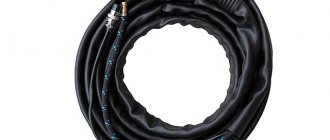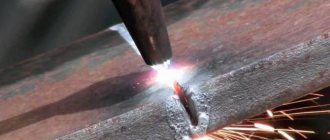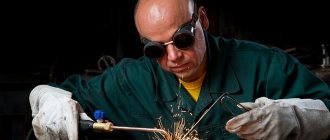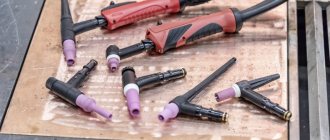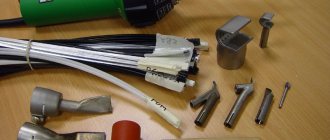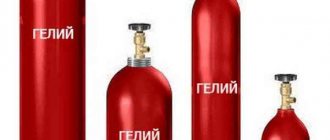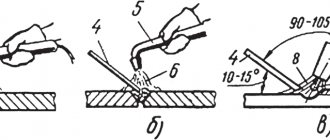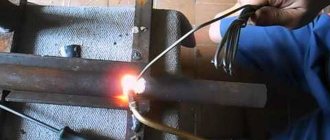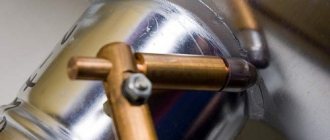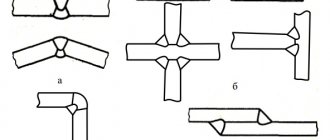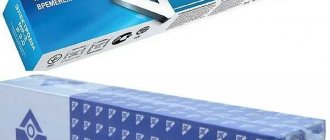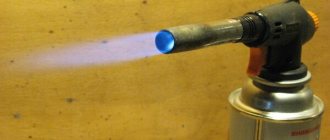The welding torch is the main part of the welding equipment. It is responsible for ensuring the supply of electric current to the electrode during electric welding. A gas welding torch is necessary to create a gas welding flame, which heats and melts the metal.
The torch for the welding machine comes in various types and is intended for performing various welding works on metal.
General information
The main device for welding parts with gas mixtures, the torch is a tool for creating a high-temperature flame. With its help, a narrow torch is obtained that heats a limited area of the connection of parts. Combustible gases, such as argon, propane, are supplied to the nozzle and mixed with oxygen, creating a flammable mixture. By changing the ratio of substances and the rate of supply of the gas mixture, the flame temperature is adjusted .
Main components of a gas injector:
- insulating sleeve;
- nozzle;
- diffuser;
- mixing chamber;
- gas supply regulators;
- cable connectors;
- handle with power button;
- cable;
- connector
Depending on the design, there are other parts, including nozzle cooling, a piezoelectric element for ignition, and a feeding device.
Passing the mixing chamber, the gas is sprayed into several jets. This allows you to obtain a homogeneous gas mixture. It then enters the nozzle where combustion occurs. The mouthpiece on the tip tube forms a torch.
Fire has a temperature higher than that at which metal melts . As a result, a weld pool is created in which the edges of the parts and the filler wire are in a liquid state.
Argon arc torch for welding machine
This type of fastening of parts combines the features of arc and gas welding. Thus, an electric discharge starts the operation of the device, and a special gas protects the seam from the penetration of oxygen. Therefore, the resulting seams have a long service life. The consumable material is tungsten wire. The burner consists of:
- a special hose through which argon is supplied;
- power core through which alternating current passes;
- handles with head.
The device is cooled by air or water. In the latter case, the design is supplemented with a hose for transporting water.
Peculiarities
The welding torch heats and melts the edges of the metals being joined with a flame. To connect them, filler wire is fed into the bath to facilitate mixing of liquid steels. Features of gas welding:
- works without electricity;
- low cost of tools and consumables;
- metal spattering is much less;
- does not require a specially equipped welding station.
The disadvantages of gas welding include a fire hazard, the likelihood of the flame being drawn into the nozzle, its overheating and explosion . Manual adjustment of the mixture feed speed is not always convenient, especially if you have to weld metals of different thicknesses and compositions. Each cylinder has its own reducer and shows gas consumption in liters per minute. To obtain the desired temperature, you should adjust the supply of constituent substances one by one.
Features of welding work using a gas torch
First of all, gas torches are distinguished by the fact that they are perfect for semi-automatic or automatic welding work, when the welding wire is fed without the use of hands, which greatly facilitates the technological process.
Thanks to automatic welding, you can qualitatively weld all hard-to-reach areas, and you will have to apply a minimum amount of effort. The amount of waste from such work is minimal. The weld seam is quite strong in a much shorter period of time than during electric arc welding. There are not too many disadvantages to this technology; they relate, first of all, to the rather high cost of equipment and components. The entire system is complex in terms of design; the products are very heavy and bulky, so moving them from one place to another will be very problematic.
The welding process consists of the following stages:
- The areas of the parts to be welded must be thoroughly cleaned of all traces of rust or corrosion. You can do this using a special metal brush attached to an angle grinder.
- Be sure to degrease the surface using TIG or other compounds, otherwise the consumable electrode will not adhere too tightly to the metal;
- The gas burner is activated, the semi-automatic electrode supply mechanism is started and the direct work of connecting metal elements begins;
- Be sure to set the electrode feed speed. It depends on the type of metals being welded, their thickness and a number of other factors.
Classification
The burner has an injection and non-injector gas supply mechanism. It can work with gaseous consumables, when 2 gases are combined and a flammable mixture is obtained. Liquid injectors use gasoline or kerosene sprayed into a stream of oxygen.
For welding, different designs of torches are used depending on the type of gas consumed:
- propane;
- acetylene;
- argon.
Propane torches for metal welding are characterized by safe operation and simple design . They are used to connect parts with various configurations, thick-walled workpieces made of low-alloy and medium-carbon steels. Propane is supplied from a cylinder or directly from the system through a reducer and hose.
Experts know that burners such as acetylene and argon produce high temperatures. They can melt refractory steels, aluminum and its alloys.
Design
The design features of welding equipment in general and the torch in particular significantly affect the quality of the work performed and allow the welder to solve problems. That is why, before purchasing this most important component of the welding process, you should pay attention to its individual components.
Regardless of the brand and specific manufacturer of the welding torch, it usually consists of the following basic parts:
- the so-called “neck” (“gander”), which is the supporting element of the burner;
- various types of insulators (bushings and washers) that can be replaced either individually or together with the nozzle;
- a diffuser (or holder) that needs to be replaced only in case of very intensive use;
- the working nozzle, which is the most vulnerable part of the welding torch, constantly exposed to particles of straightened metal;
- supply hose with plugs, cable connectors and other connectors;
- current tip requiring periodic replacement.
Most of the listed parts included in the design of pin-type burners wear out greatly over time and then become unusable. Every welder always tries to have a certain supply of basic spare parts, eliminating the situation when welding must be interrupted at the most inopportune moment.
With or without an injector?
Inside welding torches, gas mixing occurs according to 2 principles. Based on this, they are divided:
- non-injector;
- injection.
The technical characteristics of the devices depend on the method of preparing the mixture. In addition, there is a division according to the type of welding.
Without injector
In non-injector models, gas flows from the cylinders through separate channels into the mixing chamber . On the back of the handle there are sockets for connecting to hoses. Valves of different colors regulate the flow of each component of the mixture separately. With their help, the temperature of the torch changes by changing the ratio of oxygen and combustible gas.
Each stream is divided into thin jets before entering the chamber. This improves the mixing of oxygen and fuel component. This mixing technology allows you to work with low pressure and accurately regulate the temperature.
Disadvantages include the possibility of fire getting inside the nozzle and mixing chamber. As a result, the holder may explode.
With injector
The injector allows you to regulate the pressure of only oxygen . The channel into the mixing chamber passes past the flammable gas input hole. High flow speed creates a zone of rarefied air with low pressure. Gas rushes into it and mixes with oxygen.
For a burner with an injector, it is sufficient to supply only oxygen at high pressure. There is a high-quality mixing of the constituent components. The high exit speed of the gas mixture does not allow the flame to enter the nozzle.
The disadvantages include the inability to regulate the gas ratio. As a result, the fire burns unevenly. Oxygen is supplied under high pressure and at high speed. Otherwise, a low pressure zone is not created and propane does not flow.
Where to buy welding torches in Ukraine at an affordable price
The Ukrservice online store has a wide range of equipment for various types of welding. The catalog presents products from reliable global manufacturers Binzel
,
Fronius
,
Jasic
,
Sigma
,
Donmet
. Managers of the trading house will tell you what types of welding torches are available and what are their main differences. “Ukrservice” is the official importer of the above brands, so customers have access to the best prices for instruments for metal welding.
Welding equipment catalog
How to work?
First, let in flammable gas, then oxygen and ignite the mixture coming out of the nozzle. Adjust the flow rate based on the color of the flame or instrument readings. Direct the torch to the beginning of the weld. Bring in the filler wire. When a pool forms, move the molten metal forward, forming a seam.
Having reached the end of the connection, remove the filler wire and turn off the gas in the reverse order.
Argon welder of the 6th category, master of assembly and welding of containers for chemicals Osadchiy M.K.: “Gas burners, depending on the design, have 2 operating modes - starting: 2-stroke and 4-stroke. If the technical data sheet indicates an operating mode of 2 strokes, then the start button on the torch body should be pressed at the beginning of welding and released after completion of work. In 4-stroke mode, the first time you press the button, the gas supply is turned on. When it is released, the welding process itself begins. When the start button is pressed a second time, welding stops and gas stops flowing when the button is released. Burners with a 4-cycle switching mode are suitable for semi-automatic machines; they allow you to control the supply of protective gas to the bath before heating begins and before cooling. These torches are convenient for welding long seams; you don’t have to keep your finger pressed on the button for a long time.”
Popular types
There are many models of gas burners, each with its own design features. Which welding mode to choose depends on the materials being welded and the amount of work . If a pipe leaks at home, it can be repaired with a simple piezotorch with filler wire.
To make plumbing and repair a car, you will need a manual semi-automatic device or a gas device operating in TIG mode.
For semi-automatic
The semi-automatic machine works with filler and welding wire, which is automatically fed into the bath at a constant speed. It can only be used as an additive and melts due to burning gas. In most machines, the wire is also an electrode, at the end of which an arc is created.
All modes are configured before welding begins . After this, with a change in current strength, the amount of supplied gas and the wire feed speed increase.
The length of the hose for supplying consumables is 3 – 5 m.
A simple device allows you to assemble the burner yourself, even without having a drawing yourself. Any house requires welding work during construction and furnishing. The amount of work is small and buying a device is expensive; making a homemade one will cost less.
For argon arc
Argon arc welding is performed in TIG mode. It allows you to cook refractory materials such as aluminum. In the center of the nozzle there is a holder for a tungsten electrode. The arc is constantly in a protective atmosphere.
The gas is adjusted using a valve on the handle. Sleeve length 4 – 8 m.
For spot welding
The devices operate in TIG – WIG mode. They are distinguished from other nozzles by a shaped nozzle, which covers a flint mouthpiece with a tungsten non-consumable electrode. The principle of operation is the spot melting of metal on one or both sides . The connection has neat weld points. No filler wire is used; only the metal of the parts being welded is melted.
At the moment of formation of the connection, the non-consumable electrode is located inside the mouthpiece in a gas environment, which creates additional heating and high pressure. It takes a few seconds to create one weld point. The welder's hand presses the mouthpiece to the metal and presses the button.
To use spot welding, a copper sheet is placed under the parts - an underlayer that removes excess heat and at the same time acts as a current collector.
At the end of welding, the wire afterburner turns on. It completes the formation of the welding site, preventing the wire from cooling sharply.
How to choose an acetylene torch
When choosing, focus on safety
The retail chain sells many modifications of welding torches, both domestic and Western. The acetylene torch tip comes in sizes 0 to 7.
The main selection parameters depend on the parameters of the parts being welded:
- thickness of welded units;
- chemical composition of the metal being welded;
- size of the connecting weld.
Top 6 reliable burners
Today the most popular devices are:
- acetylene torch g2 - m "Malyutka" - for soldering with high-temperature solder, price: 2650 rub.;
- acetylene torch g2 - 4 m, with 4 seamless tips: from 0 to 3 sizes, with a possible thickness of the welded metal from 0.3 to 8.0 mm, price: 2559 rubles;
- acetylene torch GS - 2, with a thickness of welded metal from 0.5 to 5.0 mm, price: 1250 rubles;
- acetylene torch g2 - 23, with a thickness of welded metal from 1.0 to 4.0 mm, price: 1439 rubles;
- acetylene burner GS -3, with tips 4.6, climatic version +45C to -40C, price: 1197 rub.
Pros and cons of piezo modifications
For amateurs who periodically carry out welding work, it is convenient to use a gas torch with piezo ignition. It is a can of gas with a nozzle installed on its neck .
The portable welding machine is adjusted by the gas mixture supply screw. Simply press the button and the piezoelectric element produces a spark, igniting the torch. You can work in any conditions, except for cold temperatures below – 20⁰, when the liquefied gas in the cylinder begins to freeze.
The disadvantages of small burners with piezo ignition are their small volume and disposal . The cylinder and nozzle are a one-piece, disposable device. When the gas runs out, the equipment has to be thrown away, having previously vented the remaining gas so that an accident does not occur.
The piezoelectric element for igniting the torch is used on gas nozzles for argon arc and TIG welding. When you press the button, a spark appears, igniting the gas.
Blowtorches and torches
Such devices are connected directly to the cylinder. To do this, they need to be placed on a cylinder.
Gas cutters and blowtorches are used for construction and repair work.
- Kemper micro 12500. This gas burner with a built-in cartridge can work for more than an hour without interruption. The device is quite expensive. The device is comfortable to hold in your hand thanks to the rubberized textured coating. The burner is also stable in its stand. It has a flame power regulator. The only thing you may not like is the unusual location of the control buttons.
- Turbojet TJ8250-M. This burner operates on a long hose. This makes working with it convenient and safe. Comfort is enhanced by the ergonomic handle. The device has high power. There is a drawback in the form of a long connection to the cylinder.
- REXANT GT-19. Among the burners presented, this model stands out for its lowest price. Using gas economically, the burner can produce a powerful flame. As in previous models, the flame strength can be adjusted here. Minus - it is better not to use the device in severe frost, as it begins to slow down.
